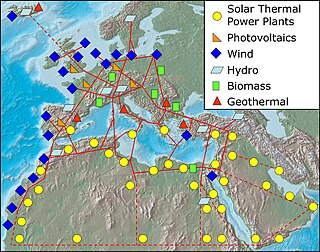The Global Energy Interconnection is a proposed global electricity network (Super grid).

The Global Energy Interconnection is a proposed global electricity network (Super grid).

The idea was conceived by State Grid Corporation of China (SGCC), and put forward by SGCC Chairman Liu Zhenya, at a workshop on November 12, 2015. [1] [2]

The State Grid Corporation of China (SGCC), commonly known as the State Grid, is a Chinese state-owned electric utility corporation. It is the largest utility company in the world. As of 2022, State Grid is the world's third largest company overall by revenue, behind Walmart and Amazon. In 2022 it was reported as having 871,145 employees, 1.1 billion customers and revenue equivalent to US$460 billion. It is overseen by the State-owned Assets Supervision and Administration Commission of the State Council.

A submarine power cable is a transmission cable for carrying electric power below the surface of the water. These are called "submarine" because they usually carry electric power beneath salt water but it is also possible to use submarine power cables beneath fresh water. Examples of the latter exist that connect the mainland with large islands in the St. Lawrence River.

Ensuring adequate energy supply to sustain economic growth has been a core concern of the Chinese government since 1949. The country is the world's largest emitter of greenhouse gases, and coal in China is a major cause of global warming. However, from 2010 to 2015 China reduced energy consumption per unit of GDP by 18%, and CO2 emissions per unit of GDP by 20%. On a per-capita basis, it was the world's 51st largest emitter of greenhouse gases in 2016. China is also the world's largest renewable energy producer. China is the largest producer of hydroelectricity, solar power and wind power in the world. The energy policy of China is connected to its industrial policy. The goals of China's industrial policy dictate its energy needs.

China Southern Power Grid Company Limited is one of the two Chinese state-owned enterprises established in 2002 according to the precept to reform the power system promulgated by the State Council, the other being State Grid Corporation of China (SGCC). It is overseen by the State-owned Assets Supervision and Administration Commission of the State Council and it manages investment, construction and management of power transmission, transformation and distribution covering China's five southern provinces of Guangdong, Guangxi, Yunnan, Guizhou and Hainan, while power generation is done by five other power generation groups. The company is headquartered in Guangzhou, Guangdong.
Unified National Smart Grid as well as Unified Solar is a proposal for a nationally interconnected grid relying on a backbone of electric power transmission lines linking the US' local grids that have been upgraded to smart grids. Europe's analogous project is sometimes referred to as the SuperSmart Grid.

China's electric power industry is the world's largest electricity producer, passing the United States in 2011 after rapid growth since the early 1990s. In 2021, China produced 8.5 petawatt-hour (Pwh) of electricity, approximately 30% of the world's electricity. In 2019, China had produced 7.3 petawatt-hour (PWh) of electricity, more than the next three countries combined.

An electrical grid is an interconnected network for electricity delivery from producers to consumers. Electrical grids vary in size and can cover whole countries or continents. It consists of:

A wide area synchronous grid is a three-phase electric power grid that has regional scale or greater that operates at a synchronized utility frequency and is electrically tied together during normal system conditions. Also known as synchronous zones, the most powerful is the Northern Chinese State Grid with 1,700 gigawatts (GW) of generation capacity, while the widest region served is that of the IPS/UPS system serving most countries of the former Soviet Union. Synchronous grids with ample capacity facilitate electricity trading across wide areas. In the ENTSO-E in 2008, over 350,000 megawatt hours were sold per day on the European Energy Exchange (EEX).

A super grid or supergrid is a wide-area transmission network, generally trans-continental or multinational, that is intended to make possible the trade of high volumes of electricity across great distances. It is sometimes also referred to as a "mega grid". Super grids typically are proposed to use high-voltage direct current (HVDC) to transmit electricity long distances. The latest generation of HVDC power lines can transmit energy with losses of only 1.6% per 1,000 km.
Ultra-high-voltage electricity transmission has been used in China since 2009 to transmit both alternating current (AC) and direct current (DC) electricity over long distances separating China's energy resources and consumers. Expansion of both AC and DC capacity continues in order to match generation to consumption demands while minimizing transmission losses. Decarbonization improvements will result from the replacement of lower efficiency generation, located near the coast, by more modern high-efficiency generation with less pollution near the energy resources.

Elering AS is a national transmission system operator for electricity and natural gas with headquarters in Tallinn, Estonia. The managing director of Elering is Taavi Veskimägi.
Lithuania is a net energy importer. In 2019 Lithuania used around 11.4 TWh of electricity after producing just 3.6 TWh.

China is the world's largest consumer of electricity, and its demand is expected to double by the next decade, and triple by 2035. In 2010, 70 percent of the country's electricity generation came from coal-fired power plants, but the Chinese government is investing heavily in renewable energy technologies. As of 2013, 21 percent of China's electricity generation comes from renewable sources. This represents only 9 percent of overall primary energy consumption in the country. China's latest goal is to increase renewable energy to 9.5 percent of overall primary energy use by 2015. To implement China's new clean energy capacity into the national power grid, and to improve the reliability of the country's existing infrastructure, requires significant upgrades and ultimately, a smart grid.
ElectraNet Pty Ltd, trading as ElectraNet, is an electricity transmission company in South Australia. It operates 5,591 km of high-voltage electricity transmission lines in South Australia.
The Southern Hami–Zhengzhou UHVDC is an ultra high-voltage direct current power transmission line from the north-west to central China.

The electricity sector in Macau ranges from generation, transmission, distribution and sales of electricity in Macau, China.
An interconnector is a structure which enables high voltage DC electricity to flow between electrical grids. An electrical interconnector allows electricity to flow between separate AC networks, or to link synchronous grids. They can be formed of submarine power cables or underground power cables or overhead power lines.

Turkish Electricity Transmission Corporation is the transmission system operator for electricity in Turkey. It is a government-owned corporation. It is planned for a minority stake to be sold to the private sector before the end of 2022. It reportedly does not co-ordinate with EMRA re YEKA bids as of 2023.
Green Grids Initiative — One Sun, One World, One Grid is an initiative by International Solar Alliance (ISA), India, France and United Kingdom to build a global green energy grid, primarily focusing on solar and wind energy.